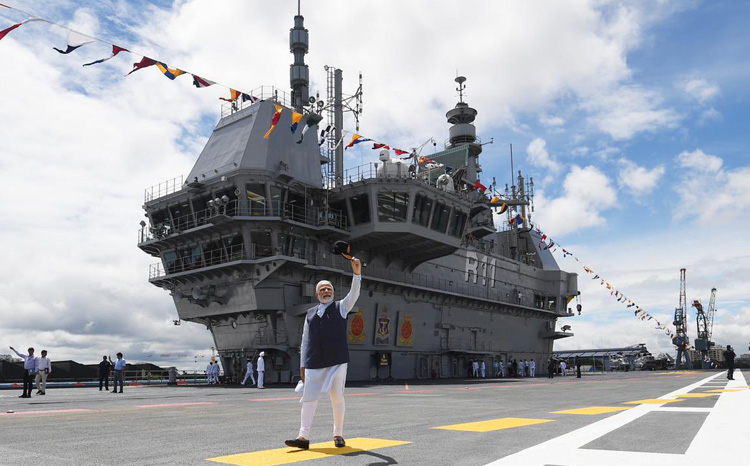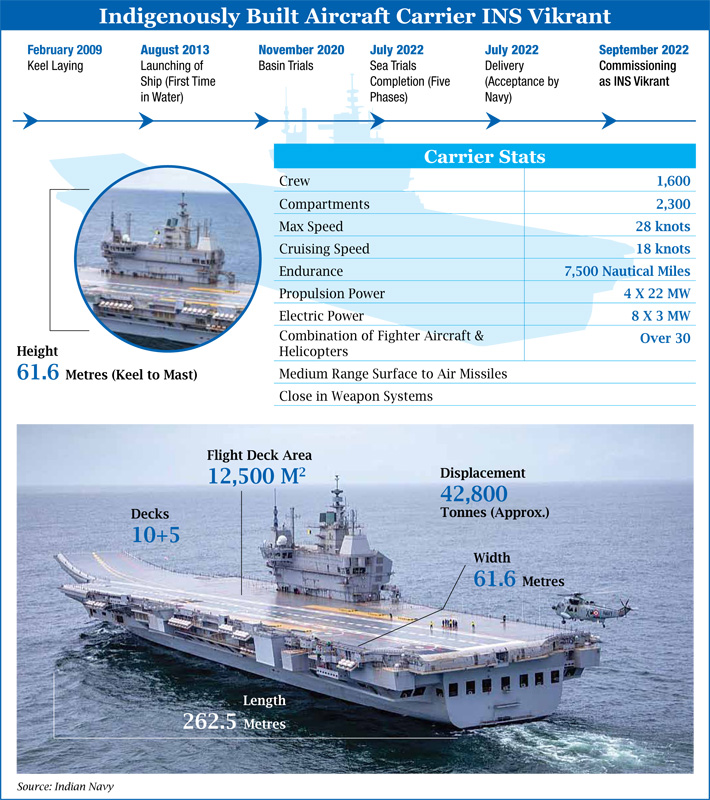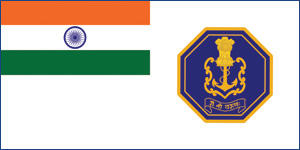INDIAN ARMED FORCES CHIEFS ON OUR RELENTLESS AND FOCUSED PUBLISHING EFFORTS

The insightful articles, inspiring narrations and analytical perspectives presented by the Editorial Team, establish an alluring connect with the reader. My compliments and best wishes to SP Guide Publications.

"Over the past 60 years, the growth of SP Guide Publications has mirrored the rising stature of Indian Navy. Its well-researched and informative magazines on Defence and Aerospace sector have served to shape an educated opinion of our military personnel, policy makers and the public alike. I wish SP's Publication team continued success, fair winds and following seas in all future endeavour!"

Since, its inception in 1964, SP Guide Publications has consistently demonstrated commitment to high-quality journalism in the aerospace and defence sectors, earning a well-deserved reputation as Asia's largest media house in this domain. I wish SP Guide Publications continued success in its pursuit of excellence.
- MoD initiates comprehensive review of Defence Acquisition Procedure 2020, pushes for defence reforms
- G7: The Swansong
- Kalinga Connect: South Asia to Polynesia
- Advanced MRSAM for India for a greater firepower
- Must Credit DRDO for Operation Sindoor, now what is next for defence R&D?
- Operation Sindoor | Day 2 DGMOs Briefing
- Operation Sindoor: Resolute yet Restrained
MAKE IN INDIA / AIRCRAFT CARRIER
INS Vikrant: India’s Indigenous, Vast, & Special Warship Commissioned
Prime Minister Modi commissioned the first indigenous aircraft carrier INS Vikrant, the largest ship ever built in the maritime history of India and houses state-of-the-art automation features

In yet another boost towards the self-reliant defence sector, INS Vikrant, the country’s first indigenous aircraft carrier Indian Naval Ship (INS) Vikrant was commissioned at Cochin Shipyard Limited (CSL) on September 2, 2022 by Prime Minister Narendra Modi. With the commissioning, India has entered into a select band of Nations having niche capability to indigenously design and build an Aircraft Carrier and real testimony to the Nation’s resolve for self-reliance and ‘Make in India’, read the official statement.
Addressing the gathering, the Prime Minister stated INS Vikrant’s commissioning to be the sunrise of a new future. “Today we are seeing a manifestation of the dream of the freedom fighters where they envisioned a capable and strong India. Vikrant is huge, massive, and vast. It is distinguished and special. Vikrant is not just a warship, this is a testament to the hard work, talent, influence, and commitment of India in the 21st century. If the goals are distant, the journeys are long, the ocean and the challenges are endless – then India’s answer is Vikrant. The incomparable Amrit of Azadi ka Amrit Mahotsav is Vikrant. Vikrant is a unique reflection of India becoming self-reliant. If every citizen of India starts living the mantra of ‘Vocal for Local’, then it will not take long for the country to become self-reliant.”
INS Vikrant has been made using indigenous equipment and machinery supplied by India’s major industrial houses as well as over 100 MSMEs
The ship has been christened after India’s first aircraft carrier Vikrant, build up towards enhanced maritime security in the Indian Ocean Region. Vikrant stands as a symbol of India’s manufacturing prowess and advancing indigenous technology, resources, and skills. The Prime Minister acknowledged and praised the contribution of the Navy, engineers of Cochin Shipyard, scientists, and especially the workers who worked on the project. The steel installed in Vikrant’s airbase is also indigenous, developed by DRDO scientists, and produced by Indian companies. Calling the Carrier, a floating city, the Prime Minister informed that it produces electricity that is sufficient to power 5,000 households and the wiring used will reach Kashi from Kochi. The Defence Minister highlighted a series of steps taken by Ministry of Defence to achieve ‘Atmanirbharta’ that includes setting up of defence corridors in Uttar Pradesh and Tamil Nadu; issuance of three positive indigenisation lists; earmarking of 68 per cent of the capital procurement budget for domestic industry; Defence Production and Export Promotion Policy 2020 and increase in FDI limit. The aim, he said, is ‘Make in India, Make for the World’ and exports of more than $400 billion in the last year is a proof of this vision.
INS Vikrant is an example of Government's thrust to making India's defence sector self-reliant. https://t.co/97GkAzZ3sk
— Narendra Modi (@narendramodi) September 2, 2022
??? ?????? ???????? ?? captain, ?? crew ?? ?????? ?? ???????? ??? ????? ?? ????? ???? ???? ????? ???? ?? ???????????? ??? ???? ????? '?? ?? ?????' ???? ‘May the Lord of the Water, be auspicious unto us’ ?? ????? ???? ???: ????? ??????
— ????? ?????? ????????/ RMO India (@DefenceMinIndia) September 2, 2022
INS Vikrant is designed by the Indian Navy’s in-house Warship Design Bureau (WDB) and built by Cochin Shipyard Limited, a Public Sector Shipyard under the Ministry of Ports, Shipping & Waterways. Vikrant has been built with state-of-the-art automation features and is the largest ship ever built in the maritime history of India.
Chief of the Naval Staff Admiral R. Hari Kumar voiced the Navy’s resolve for India@100 to become completely self-reliant until 2047, consisting of ‘Made in India’ ships, submarines, aircraft, unmanned vessels, and systems and remain a ‘Combat Ready, Credible, Cohesive and Future-Proof Force’. “The Navy is determined to move forward on the path of five pledges - developed India, removing any sign of servility, pride in heritage, unity, and fulfilling the duties - as envisioned by the Prime Minister,” he said. The Chief of the Naval Staff further exhorted the Commanding Officer and crew of INS Vikrant to take forward the proud legacy of erstwhile Vikrant which served the country for 36 glorious years and played a significant role in the 1971 war.

Defence Minister, Rajnath Singh also termed the commissioning of INS Vikrant at the onset of ‘Amritkal’ as a testament to the Government’s strong resolve to ensure the safety and security of the nation in the next 25 years. “INS Vikrant is a glowing symbol of an aspirational and self-reliant ‘New India’. It is an icon of pride, power, and resolve of the Nation. Its commissioning is an unprecedented achievement in the path of building indigenous warships. Indian Navy’s tradition is ‘old ships never die’. This new avatar of Vikrant, which played a stellar role in the 1971 war, is a humble tribute to our freedom fighters and brave soldiers,” he said.
The Prime Minister went on to talk about the Indian Maritime tradition and naval capabilities. The geo-strategic situation has been changing and security concerns have been rising in the Indo-Pacific region and the Indian Ocean. To appropriately make use of this major defence area, the government is taking various steps, from increasing the budget for the Navy to increasing its capability.
Marking a departure from the colonial past, Prime Minister unveiled the new Naval Ensign, dedicates the Ensign to Chhatrapati Shivaji
The 262.5 m long and 61.6 m wide Vikrant displaces approx 43,000 T, having a maximum designed speed of 28 Knots with endurance of 7,500 Nautical Miles. The ship has around 2,200 compartments, designed for a crew of around 1,600 including women officers and sailors. The carrier is designed with a very high degree of automation for machinery operations, ship navigation and survivability. The carrier is equipped with the latest state of the art equipment and systems.
The ship is capable of operating air wing consisting of 30 aircraft comprising of MiG-29K fighter jets, Kamov-31, MH-60R multi-role helicopters, in addition to indigenously manufactured Advanced Light Helicopters (ALH) and Light Combat Aircraft (LCA) (Navy). Using a novel aircraft-operation mode known as Short Take Off But Arrested Recovery (STOBAR), INS Vikrant is equipped with a ski-jump for launching aircraft, and a set of ‘arrester wires’ for their recovery onboard.

Rajnath Singh also asserted that it is a key responsibility of the Indian Navy to secure the country’s maritime interests for uninterrupted maritime trade, amid the constantly-changing global situation and exuded confidence that the commissioning of INS Vikrant will further enhance the force’s capability. “This is an assurance to the friendly foreign countries that India is fully capable of meeting the collective security needs of the region. We believe in a free, open and inclusive Indo-Pacific. Our efforts in this regard are guided by ‘SAGAR’ (Security and Growth for All in the Region) as envisioned by the Prime Minister,” he added.
“As India is moving rapidly towards a $5 trillion economy, our share in global trade will increase in the coming times. If the share will increase, a large part of it will inevitably be through maritime routes. In such a situation, INS Vikrant will prove to be crucial to safeguard our security and economic interests,” the Defence Minister said.
Governor of Kerala, Arif Mohammad Khan, Chief Minister Pinarayi Vijayan. Union Ministers Sarbananda Sonowal, V. Muraleedharan, Ajay Bhat, National Security Advisor, Ajit Doval and senior other civil & military officials of Ministry of Defence and CSL were among those present on the occasion.
New Ensign of Navy
During the event, the Prime Minister also unveiled the new Naval Ensign. He dedicated the new ensign to Chhatrapati Shivaji. The revealing of the new sign is being touted as a step to do away with the colonial past and befitting the rich Indian maritime heritage. Doing away with the colonial past and connecting with the nation’s roots were among the five “prans” that Modi pointed toward in his speech on Independence Day marking Azaadi ka Amrit Mahotsav. The Indian Navy has got a new flag today; from today onwards, inspired by Chhatrapati Shivaji, the new Navy flag will fly in the sea and in the sky, stated the Prime Minister.

Resonant to the ongoing national endeavour to move away from the colonial past, the need was felt to transition to a new design that drew inspiration from our history. The White Ensign identified nationwide with the Navy, now comprises two main constituents - the National Flag in the upper left canton, and a Navy Blue - Gold octagon at the centre of the fly side (away from the staff). The Octagon is with twin golden octagonal borders encompassing the golden National Emblem (Lion Capital of Ashoka – undescribed with ‘Satyamev Jayate’ in blue Devnagri script) resting atop an anchor; and superimposed on a shield. Below the shield, within the octagon, in a golden bordered ribbon, on a Navy Blue background, is inscribed the motto of the Indian Navy ‘Sam No Varunah’ in golden Devnagri script. The design encompassed within the octagon has been taken from the Indian Naval crest, wherein the fouled anchor, which is also associated with colonial legacy, has been replaced with a clear anchor underscoring the steadfastness of the Indian Navy.





